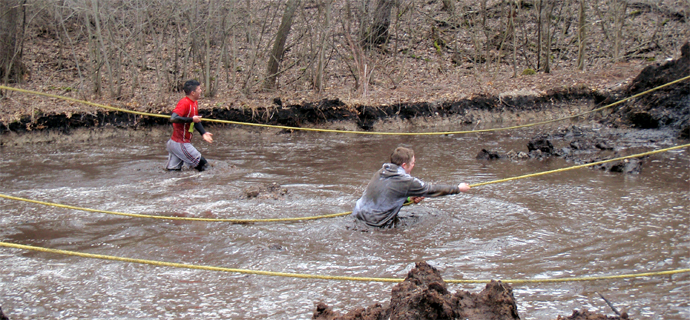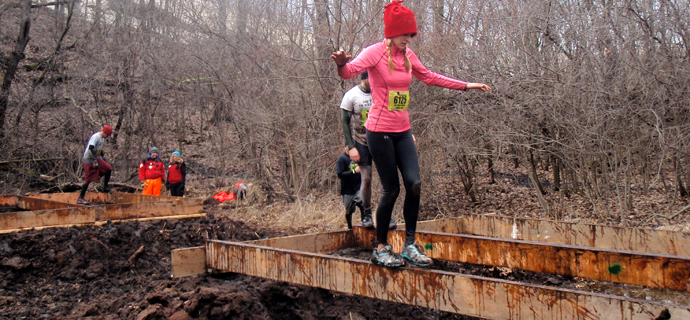
Gladiator Assault ChallengeLake Geneva – April 13, 2013
The Course
As we stood at the peak of one of the Grand Geneva ski slopes, exposed to the 17 mph winds, dozens of runners hopped up and down trying to get warm. With the temperatures hovering around 33 degrees and thick cloud cover hiding the sun, there was no escaping the cold. As the start of the 9am Gladiator Assault Challenge Elite Heat approached, people peered over the edge of a steep double black diamond slope wondering if we would eventually be climbing up or down the waiting ropes. That didn’t matter to me, I just wanted to get running since the only way we would be able to warm up was from the inside out.
The Grand Geneva Resort made for an excellent obstacle course race venue. Aside from access to extra amenities at the resort, the racecourse itself made excellent use of the terrain by repeatedly sending runners up and down the snow covered ski slopes. While the entire course was hilly, the first mile was the most taxing. If runners didn’t pace themselves well, it was easy to burn out early which would make the rest of the race more difficult.
The course was 6.7 miles long with 30 official obstacles. It took about three miles to warm up which is right when the Gladiator Assault Challenge led racers into the water. It seemed like each time I would start to warm up, the course would find more frigid water to chill us to the bone all over again.
There were three drinking water stops on the course but the first two seemed pretty early in the race. The lack of water between the second and third water stops coupled with running through cold water led to some mild muscle cramps. The aid stations did have little fire pits to give runners a chance to warm up.
During the later half of the race we ran into a wintery mix of snow and sleet but it wasn’t enough to have a real impact. The biting cold did numb my hands enough that I had I had little less confidence in my grip strength. I spent a little more time on some of the cargo nets and wall climbs just to be cautious.
Overall, the Gladiator Assault Challenge was a well executed and fun race. It would be interesting to run the course during the warmer months since I think it would be a very different experience.

The Obstacles
Gladiator Charge - Of course the Gladiator Assault Challenge start with a Gladiator Charge. The charge lead down the ski slope, back up then down again. The snow made the run slippery for some but my Salomon Speedcross 3 shoes gripped nicely.
Steeple Chase - This series of small snow hills wasn’t difficult but they did make it harder to settle into a steady pace.
Water Obstacles - There were several water obstacles and looking back it’s hard to tell them all apart. They had names like Muddy Bunkers, Pond Crossing, River’s Rage and the Fuddy Mucker. In the beginning, the water obstacles were ankle deep marshy areas but as the course continued they got deeper. The challenge with shallow water obstacles is that uneven terrain means you can’t tell if your next step will be three inches deep or ten inches. Aside from that, the real challenge was just the cold. During a summer race, the water wouldn’t even be noteworthy but for this already frigid race, the water obstacles really helped define the course.
At the end of one of the water obstacles was a short slanted concrete tunnel. It was only maybe four feet long and didn’t seem noteworthy but being careless with this obstacle had consequences. The rough concrete was pretty unforgiving and I know I left some skin behind.
The ultimate water obstacle on the Gladiator Assault Challenge had racers running across twelve inch deep water up to a cross beam. Stepping over the beam revealed the other side was much deeper. The surprise of icy waist-deep water was pretty startling. At the far side of the water were angled plastic tube that racers had to climb through to get back to dry ground. The tubes were pretty slick and there wasn’t enough room for me to crawl. I turned onto my side and pressed by back against one side and my foot against the other like a rock climber scaling a chimney.
Wall of Shame - This obstacle was a slanted wall with a rope and a couple horizontal boards to assist with the ascent. The far side of the wall had simple wooden framework to descend.
Combat Zone – Slide down angled plastic tubes into a soft mud field. I went through the tube face first but after watching other racers later, it appeared feet first was the prefered method. The mud wasn’t wet or slippery but I did sink in quite a bit and I’m sure this obstacle stole a few shoes over the course of the day.
Toast – Fire is pretty common at obstacle course racers but many of them are just a little hop over a sad looking smoldering log. The Wisconsin Tough Mudder stepped it up and had racers running between walls of flaming hay bales. The Gladiator Assault Challenge Toast was something in between with small fires to jump over but also flaming hay on the side. It was cold enough that I took it as a chance to warm up and didn’t rush through this obstacle. The flames weren’t overwhelming but with people pouring gas at their leisure, it seemed like there was potential for the fire to spread quickly.
Walls - Climbing walls are another obstacle race course staple. These walls were about seven feet tall and had a cheat step nailed toward the bottom.
Snake Bite - At the bottom of a steep hill was a wet mud pit covered with barbed wire. It was important to manage your speed on the downhill to keep your momentum when transitioning to the low crawl. It was a VERY short crawl.
High Horse Hurdles - Here there were two or three hurdles that were about waist high and pretty easy to hop over.
Sherwood Forest - Wooden beams were attached between two trees making a ladder about 40 feet high. The spacing of the beams at the very top always determines just how difficult an obstacle like this will be. The further apart those beams are, the more racers have to stretch when transitioning from one side to another. Even at almost 6’ 1” tall, I couldn’t straddle the top bar while staying in contact with both sides. I’m sure this obstacle was even more challenging once waves of racers had left it coated in mud.
Cargo Crawl - This obstacles had racers low crawling under a net lying on the ground. The net was positioned on an incline that made the crawl a little more taxing but since the net extended over the peak of the hill, it was impossible to tell how far it extended. After an barbed wire crawl that was unusually short, I was surprised at how long we had to crawl to complete this obstacle.
Cargo Climb – A pretty standard double sided A-frame cargo net climb - probably about 15 feet high.
Vertigo - This obstacle involved climbing a cargo net suspended by a cable between two trees. This cargo net was much less stable than nets mounted on wood frames. The ascent wasn’t difficult but the net swung and shifted pretty freely while crossing over the top. It was also more affected by other climbers but the sides of the net were more stable than the middle of the net.
Carry Your Wood - For this obstacle, you chose from a pile of logs to carry through the forest for probably about a quarter mile. At the turning point, you had to carry the log across muddy water. Navigating through the uneven, muddy water while balancing the log was a nice twist which brought an added challenge.
Straight Vert Ropes – Descend a steep, snow covered double-black diamond slope with the help of a rope. The slope looked pretty steep but was manageable even without the rope. If it hadn’t been covered in snow, I think most people would have run down it.
‘Nam – Barbed Wire crawl under A-frame cargo net climb. It would have been interesting to complete this obstacle during more congested waves with wet, mudder racers crossing overhead.
Ancient Peat Pits/Black Quicksand – For this obstacle, racers wade through chest deep muddy water. There were ropes to pull yourself along but they weren’t necessary.

Goats Bridge – Cross two muddy pits using the edge of a wooden plank. The first pit had a single 2” wide plank. The second plank was doubled up making it quite a bit easier. Many people’s first inclination is to go slowly and focus on keeping their balance but creeping along is a recipe for a mud bath. It’s better to move quickly, taking a couple big steps then jump.
Overhead Cargo Net - This obstacle had a cargo net suspended overhead above a pit of muddy water. It looked like a pretty simple variation on monkey bars but as I prepared to tackle the obstacle, the photographer waiting on the other side told me people were struggling with it. I felt pretty confident but swinging to my second handhold, I slid right off into the water. It felt exactly like falling off Hanging Tough at the Tough Mudder. I’m not sure why I’ve struggled with this type of obstacle but it’s definitely something I’ll have to work on.
Cargo Climb - For this obstacle, the course cross back over itself so that this is the A-frame cargo net above ‘Nam. It was a pretty straight forward double sided cargo net climb.
Overall Obstacle Difficulty Rating: 3/5
Hardest Obstacle
For me the hardest obstacle was the Overhead Cargo Net. I saw plenty of other people fall here as well and there were complaints that shorter racers couldn’t even reach the net. Some people pulled themselves up on top of the net and crawled across which is a clever technique.
Time: 1:38
Mud Rating: 2
Clean Up:
There was a shower area set up but it was so cold that nobody was using it. They also had men’s and women’s changing tents which were well heated.
Atmosphere
The Grand Geneva was a really nice venue for the race but the harsh weather put a damper on some of the festivities and it didn’t seem like people linger much longer than they had to. There is usually a little separation between the spectators’ area and the actual race course but here the course itself passed close to the hotel and bag check area with just a low ribbon for separation. It meant onlookers had a nice close view but it also meant many people crossing the course. From what I could tell most spectators were respectful of racers and were careful not to get in the way.
Another logistical challenge was the hike to the starting line. Since the Gladiator Assault course started at the top of the ski hill, racers had to walk to the top. The path to the top also crossed the race course which wasn’t a problem for the elite heat but for other waves racers had to deal with avoiding people stumbling their way to the starting line.

|
